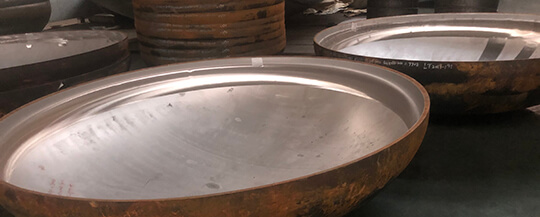Stainless steel clad plate is a composite material in which the base layer (carbon steel or low alloy steel) and the cladding layer (stainless steel) are combined into one body through a certain method, which can save expensive stainless steel, and use low carbon steel while maintaining the corrosion resistance of stainless steel. Improve the mechanical properties of materials while reducing manufacturing costs. Compared with pure stainless steel plate, it can save 70%~80% of alloy elements such as chromium and nickel, thereby saving 30%~50% of cost, and has a strong market advantage. The thickness of the stainless steel layer is generally about 4mm, the thickest in China is generally no more than 14mm, but the composite board with a total thickness from 10mm to 150mm can be produced.
Ultra-low-carbon austenitic stainless steel and low-carbon steel clad plates have been widely used in nuclear power, thermal power, petrochemical, Shipbuilding, military industry, pharmaceuticals and other fields. Therefore, ultra-low-carbon austenitic stainless steel and low-carbon steel composite plate heads have been widely used in actual production.
At present, the forming technology of the head is relatively mature, and it is not difficult to guarantee the shape. However, the hot forming and heat treatment temperature of the hot forming of the ultra-low carbon austenitic stainless steel and low carbon steel composite plate is based on the temperature of the low carbon steel. Since the two layers of materials have been combined, such as solution treatment (≥1040℃, and rapid cooling, usually water cooling), the temperature has far exceeded the normalizing temperature of low carbon steel (about 900℃), which will result in low carbon steel The layer is overheated, the grains are coarse, and the mechanical properties are greatly reduced.
On the other hand, the most important function of the ultra-low carbon austenitic stainless steel layer in use is the resistance to intergranular corrosion. Therefore, whether the ultra-low carbon austenitic stainless steel after hot forming and heat treatment can meet the requirements is the key to the safe operation of the equipment. Especially after the super-low-carbon austenitic stainless steel and low-carbon steel clad plate heads are welded to the butt barrel, they must undergo post-weld stress relief annealing (generally 600-700℃) during the equipment manufacturing process. This temperature is just at the sensitization temperature of austenitic stainless steel. The length of time depends on the process requirements, and some can be as long as 10h. This temperature is exactly the sensitization temperature of austenitic stainless steel (420~850℃). In the most stringent temperature range, after the overall equipment is manufactured, it is extremely critical to ensure the performance of the low carbon steel layer of the head and the performance of the ultra-low carbon austenitic stainless steel layer. It is of great significance to study the processing technology of composite materials to ensure that the properties of the two bonded metals meet the requirements simultaneously after manufacture.
